Patient Satisfaction & Care Plan Improvement
VerifiedAdded on 2020/07/22
|12
|4258
|51
AI Summary
This assignment focuses on enhancing patient satisfaction and improving care plans within the nursing context. It includes analyzing cross-sectional studies of US hospitals and various aspects of nursing care management, such as bundled payments (Lentz & Luther, 2017), care plan improvements in nursing homes (Mariani et al., 2017), communication tools like Health Level Seven consolidated clinical document architecture release 2 care plan (Matney et al., 2016), diabetes management in long-term care facilities (Munshi et al., 2016), end-of-life care in intensive care units (Noome et al., 2016), nursing expertise in residential care for older people (Phelan & McCormack, 2016), electronic nursing patient care plans for clinical decision support (Wong et al., 2014; Wong et al., 2017), transitional care for individuals with chronic heart failure (Yu et al., 2015), and advance care planning for end-stage renal disease patients (Yuen et al., 2016).
Contribute Materials
Your contribution can guide someone’s learning journey. Share your
documents today.
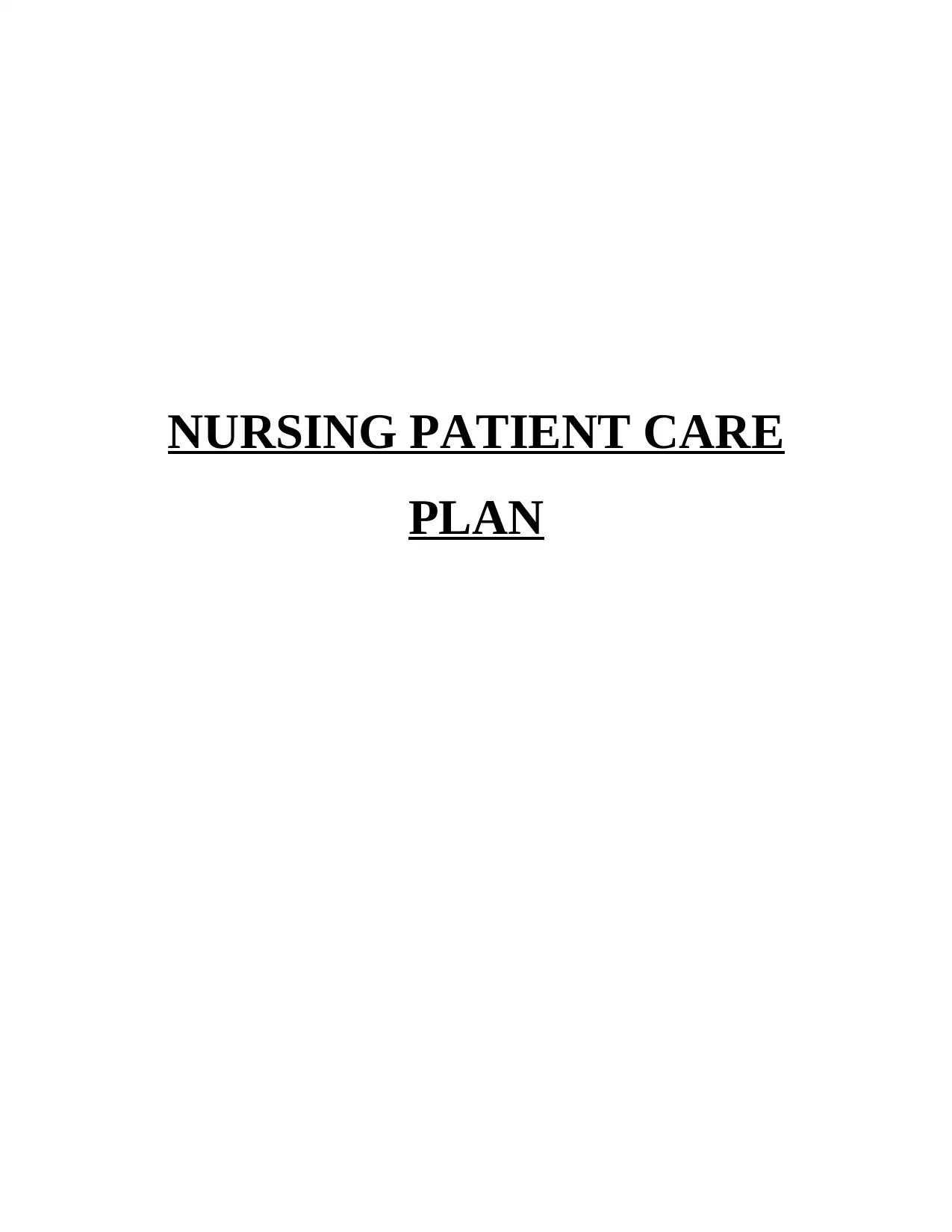
NURSING PATIENT CARE
PLAN
PLAN
Secure Best Marks with AI Grader
Need help grading? Try our AI Grader for instant feedback on your assignments.
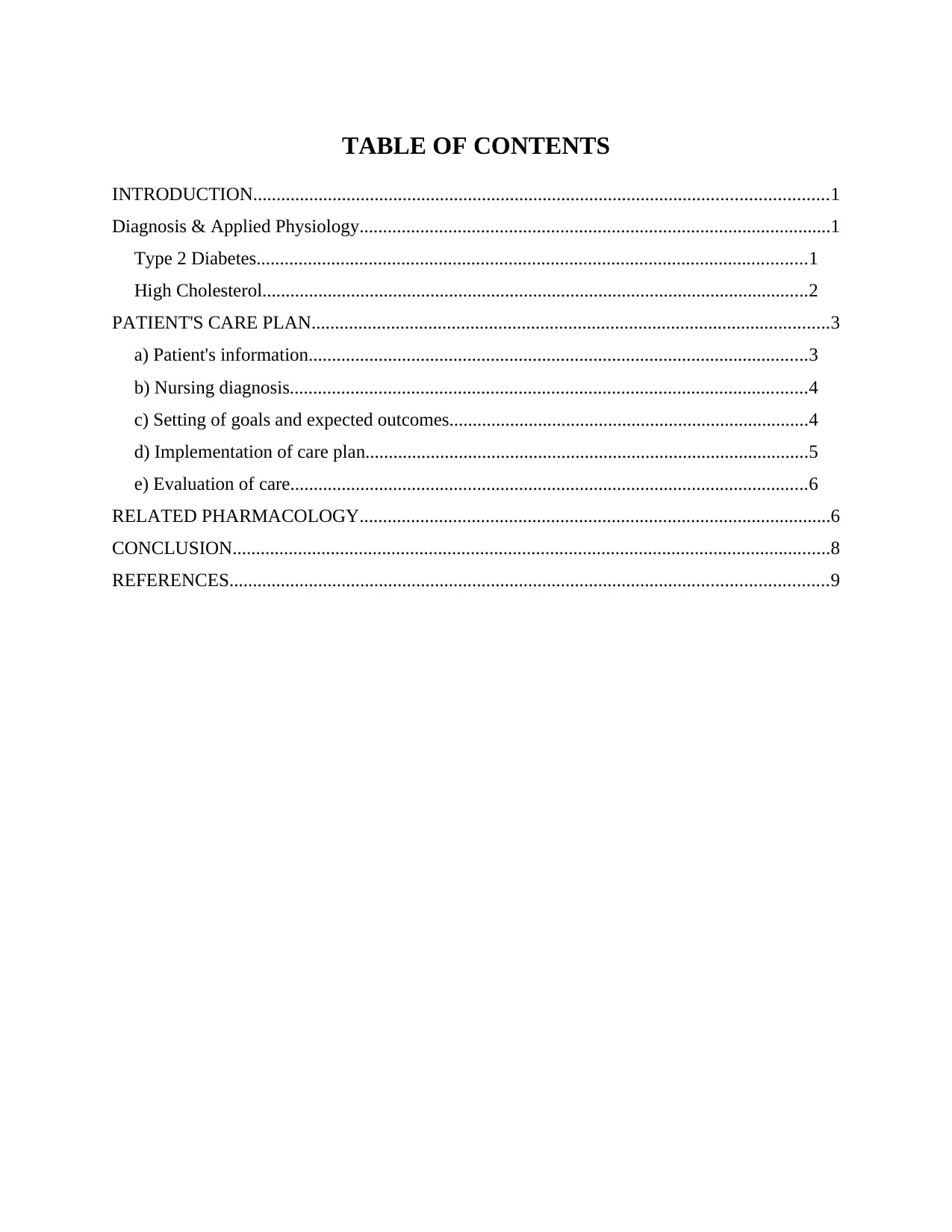
TABLE OF CONTENTS
INTRODUCTION...........................................................................................................................1
Diagnosis & Applied Physiology.....................................................................................................1
Type 2 Diabetes......................................................................................................................1
High Cholesterol.....................................................................................................................2
PATIENT'S CARE PLAN...............................................................................................................3
a) Patient's information...........................................................................................................3
b) Nursing diagnosis...............................................................................................................4
c) Setting of goals and expected outcomes.............................................................................4
d) Implementation of care plan...............................................................................................5
e) Evaluation of care...............................................................................................................6
RELATED PHARMACOLOGY.....................................................................................................6
CONCLUSION................................................................................................................................8
REFERENCES................................................................................................................................9
INTRODUCTION...........................................................................................................................1
Diagnosis & Applied Physiology.....................................................................................................1
Type 2 Diabetes......................................................................................................................1
High Cholesterol.....................................................................................................................2
PATIENT'S CARE PLAN...............................................................................................................3
a) Patient's information...........................................................................................................3
b) Nursing diagnosis...............................................................................................................4
c) Setting of goals and expected outcomes.............................................................................4
d) Implementation of care plan...............................................................................................5
e) Evaluation of care...............................................................................................................6
RELATED PHARMACOLOGY.....................................................................................................6
CONCLUSION................................................................................................................................8
REFERENCES................................................................................................................................9
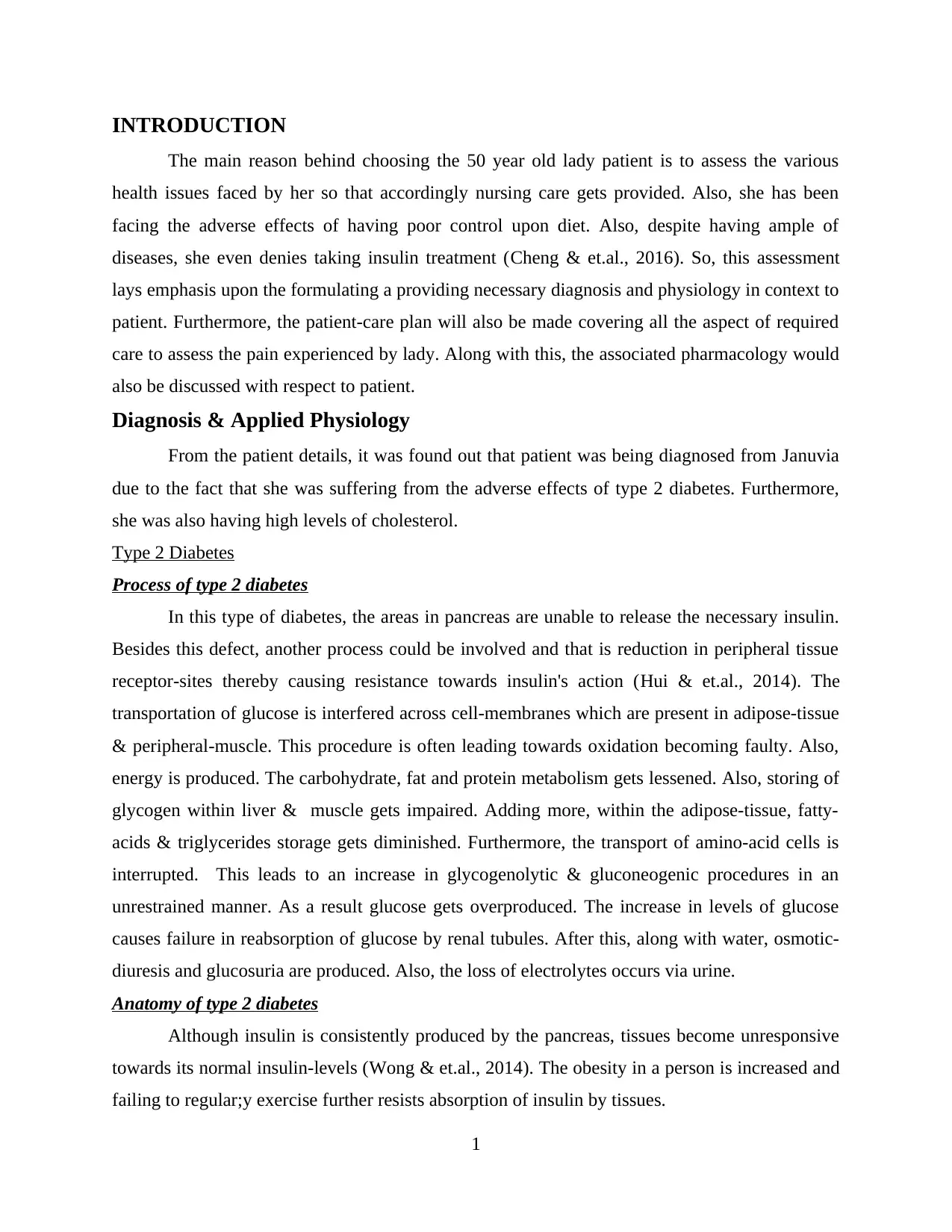
INTRODUCTION
The main reason behind choosing the 50 year old lady patient is to assess the various
health issues faced by her so that accordingly nursing care gets provided. Also, she has been
facing the adverse effects of having poor control upon diet. Also, despite having ample of
diseases, she even denies taking insulin treatment (Cheng & et.al., 2016). So, this assessment
lays emphasis upon the formulating a providing necessary diagnosis and physiology in context to
patient. Furthermore, the patient-care plan will also be made covering all the aspect of required
care to assess the pain experienced by lady. Along with this, the associated pharmacology would
also be discussed with respect to patient.
Diagnosis & Applied Physiology
From the patient details, it was found out that patient was being diagnosed from Januvia
due to the fact that she was suffering from the adverse effects of type 2 diabetes. Furthermore,
she was also having high levels of cholesterol.
Type 2 Diabetes
Process of type 2 diabetes
In this type of diabetes, the areas in pancreas are unable to release the necessary insulin.
Besides this defect, another process could be involved and that is reduction in peripheral tissue
receptor-sites thereby causing resistance towards insulin's action (Hui & et.al., 2014). The
transportation of glucose is interfered across cell-membranes which are present in adipose-tissue
& peripheral-muscle. This procedure is often leading towards oxidation becoming faulty. Also,
energy is produced. The carbohydrate, fat and protein metabolism gets lessened. Also, storing of
glycogen within liver & muscle gets impaired. Adding more, within the adipose-tissue, fatty-
acids & triglycerides storage gets diminished. Furthermore, the transport of amino-acid cells is
interrupted. This leads to an increase in glycogenolytic & gluconeogenic procedures in an
unrestrained manner. As a result glucose gets overproduced. The increase in levels of glucose
causes failure in reabsorption of glucose by renal tubules. After this, along with water, osmotic-
diuresis and glucosuria are produced. Also, the loss of electrolytes occurs via urine.
Anatomy of type 2 diabetes
Although insulin is consistently produced by the pancreas, tissues become unresponsive
towards its normal insulin-levels (Wong & et.al., 2014). The obesity in a person is increased and
failing to regular;y exercise further resists absorption of insulin by tissues.
1
The main reason behind choosing the 50 year old lady patient is to assess the various
health issues faced by her so that accordingly nursing care gets provided. Also, she has been
facing the adverse effects of having poor control upon diet. Also, despite having ample of
diseases, she even denies taking insulin treatment (Cheng & et.al., 2016). So, this assessment
lays emphasis upon the formulating a providing necessary diagnosis and physiology in context to
patient. Furthermore, the patient-care plan will also be made covering all the aspect of required
care to assess the pain experienced by lady. Along with this, the associated pharmacology would
also be discussed with respect to patient.
Diagnosis & Applied Physiology
From the patient details, it was found out that patient was being diagnosed from Januvia
due to the fact that she was suffering from the adverse effects of type 2 diabetes. Furthermore,
she was also having high levels of cholesterol.
Type 2 Diabetes
Process of type 2 diabetes
In this type of diabetes, the areas in pancreas are unable to release the necessary insulin.
Besides this defect, another process could be involved and that is reduction in peripheral tissue
receptor-sites thereby causing resistance towards insulin's action (Hui & et.al., 2014). The
transportation of glucose is interfered across cell-membranes which are present in adipose-tissue
& peripheral-muscle. This procedure is often leading towards oxidation becoming faulty. Also,
energy is produced. The carbohydrate, fat and protein metabolism gets lessened. Also, storing of
glycogen within liver & muscle gets impaired. Adding more, within the adipose-tissue, fatty-
acids & triglycerides storage gets diminished. Furthermore, the transport of amino-acid cells is
interrupted. This leads to an increase in glycogenolytic & gluconeogenic procedures in an
unrestrained manner. As a result glucose gets overproduced. The increase in levels of glucose
causes failure in reabsorption of glucose by renal tubules. After this, along with water, osmotic-
diuresis and glucosuria are produced. Also, the loss of electrolytes occurs via urine.
Anatomy of type 2 diabetes
Although insulin is consistently produced by the pancreas, tissues become unresponsive
towards its normal insulin-levels (Wong & et.al., 2014). The obesity in a person is increased and
failing to regular;y exercise further resists absorption of insulin by tissues.
1
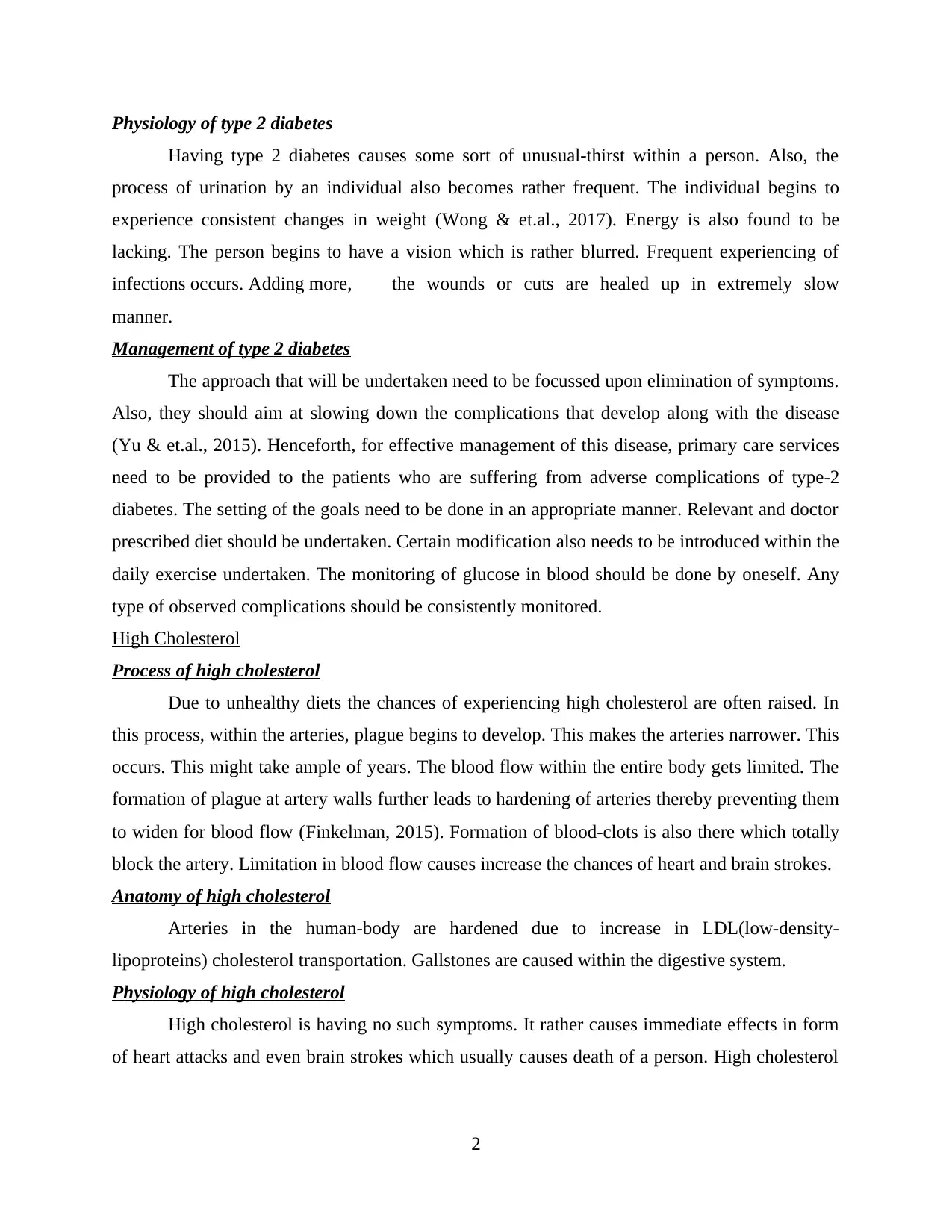
Physiology of type 2 diabetes
Having type 2 diabetes causes some sort of unusual-thirst within a person. Also, the
process of urination by an individual also becomes rather frequent. The individual begins to
experience consistent changes in weight (Wong & et.al., 2017). Energy is also found to be
lacking. The person begins to have a vision which is rather blurred. Frequent experiencing of
infections occurs. Adding more, the wounds or cuts are healed up in extremely slow
manner.
Management of type 2 diabetes
The approach that will be undertaken need to be focussed upon elimination of symptoms.
Also, they should aim at slowing down the complications that develop along with the disease
(Yu & et.al., 2015). Henceforth, for effective management of this disease, primary care services
need to be provided to the patients who are suffering from adverse complications of type-2
diabetes. The setting of the goals need to be done in an appropriate manner. Relevant and doctor
prescribed diet should be undertaken. Certain modification also needs to be introduced within the
daily exercise undertaken. The monitoring of glucose in blood should be done by oneself. Any
type of observed complications should be consistently monitored.
High Cholesterol
Process of high cholesterol
Due to unhealthy diets the chances of experiencing high cholesterol are often raised. In
this process, within the arteries, plague begins to develop. This makes the arteries narrower. This
occurs. This might take ample of years. The blood flow within the entire body gets limited. The
formation of plague at artery walls further leads to hardening of arteries thereby preventing them
to widen for blood flow (Finkelman, 2015). Formation of blood-clots is also there which totally
block the artery. Limitation in blood flow causes increase the chances of heart and brain strokes.
Anatomy of high cholesterol
Arteries in the human-body are hardened due to increase in LDL(low-density-
lipoproteins) cholesterol transportation. Gallstones are caused within the digestive system.
Physiology of high cholesterol
High cholesterol is having no such symptoms. It rather causes immediate effects in form
of heart attacks and even brain strokes which usually causes death of a person. High cholesterol
2
Having type 2 diabetes causes some sort of unusual-thirst within a person. Also, the
process of urination by an individual also becomes rather frequent. The individual begins to
experience consistent changes in weight (Wong & et.al., 2017). Energy is also found to be
lacking. The person begins to have a vision which is rather blurred. Frequent experiencing of
infections occurs. Adding more, the wounds or cuts are healed up in extremely slow
manner.
Management of type 2 diabetes
The approach that will be undertaken need to be focussed upon elimination of symptoms.
Also, they should aim at slowing down the complications that develop along with the disease
(Yu & et.al., 2015). Henceforth, for effective management of this disease, primary care services
need to be provided to the patients who are suffering from adverse complications of type-2
diabetes. The setting of the goals need to be done in an appropriate manner. Relevant and doctor
prescribed diet should be undertaken. Certain modification also needs to be introduced within the
daily exercise undertaken. The monitoring of glucose in blood should be done by oneself. Any
type of observed complications should be consistently monitored.
High Cholesterol
Process of high cholesterol
Due to unhealthy diets the chances of experiencing high cholesterol are often raised. In
this process, within the arteries, plague begins to develop. This makes the arteries narrower. This
occurs. This might take ample of years. The blood flow within the entire body gets limited. The
formation of plague at artery walls further leads to hardening of arteries thereby preventing them
to widen for blood flow (Finkelman, 2015). Formation of blood-clots is also there which totally
block the artery. Limitation in blood flow causes increase the chances of heart and brain strokes.
Anatomy of high cholesterol
Arteries in the human-body are hardened due to increase in LDL(low-density-
lipoproteins) cholesterol transportation. Gallstones are caused within the digestive system.
Physiology of high cholesterol
High cholesterol is having no such symptoms. It rather causes immediate effects in form
of heart attacks and even brain strokes which usually causes death of a person. High cholesterol
2
Secure Best Marks with AI Grader
Need help grading? Try our AI Grader for instant feedback on your assignments.
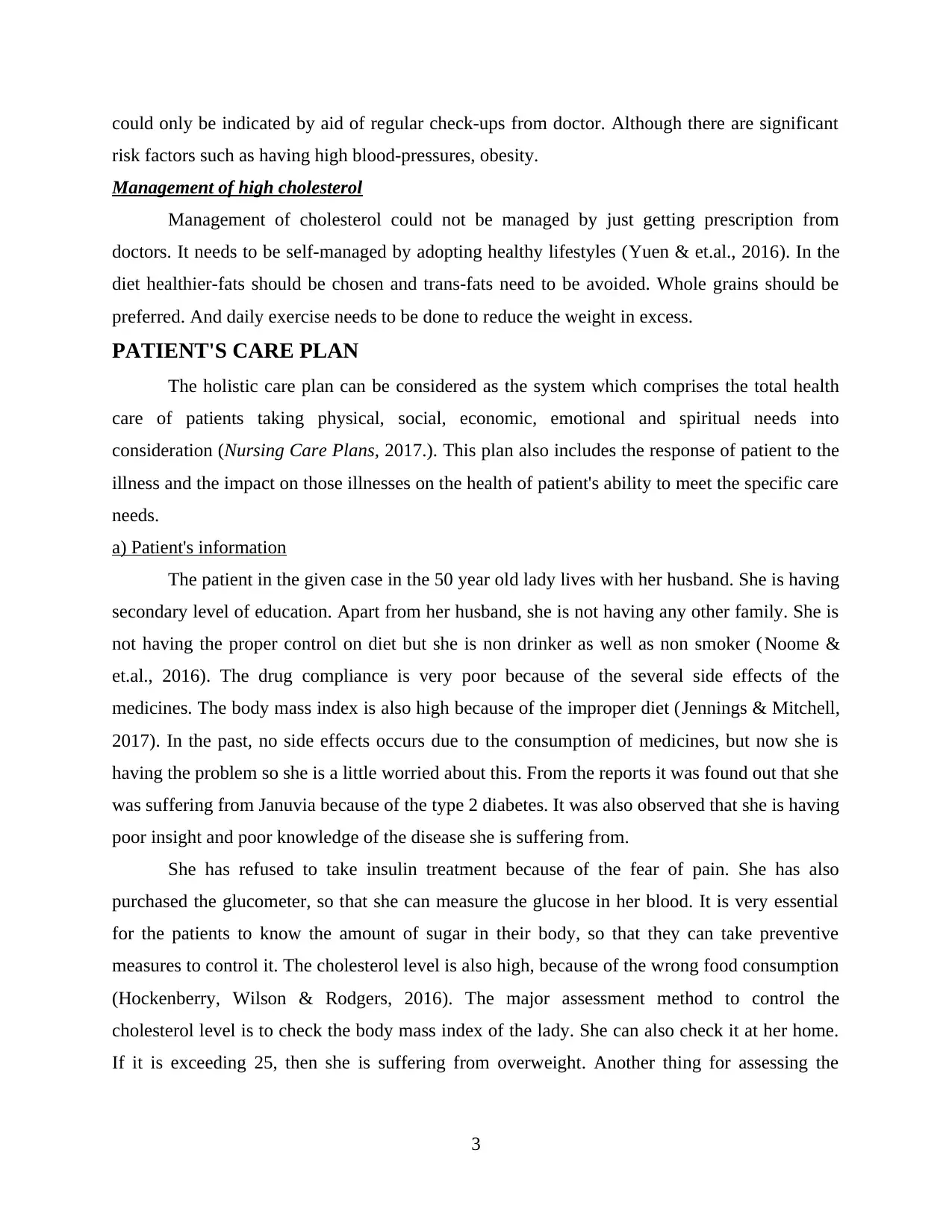
could only be indicated by aid of regular check-ups from doctor. Although there are significant
risk factors such as having high blood-pressures, obesity.
Management of high cholesterol
Management of cholesterol could not be managed by just getting prescription from
doctors. It needs to be self-managed by adopting healthy lifestyles (Yuen & et.al., 2016). In the
diet healthier-fats should be chosen and trans-fats need to be avoided. Whole grains should be
preferred. And daily exercise needs to be done to reduce the weight in excess.
PATIENT'S CARE PLAN
The holistic care plan can be considered as the system which comprises the total health
care of patients taking physical, social, economic, emotional and spiritual needs into
consideration (Nursing Care Plans, 2017.). This plan also includes the response of patient to the
illness and the impact on those illnesses on the health of patient's ability to meet the specific care
needs.
a) Patient's information
The patient in the given case in the 50 year old lady lives with her husband. She is having
secondary level of education. Apart from her husband, she is not having any other family. She is
not having the proper control on diet but she is non drinker as well as non smoker ( Noome &
et.al., 2016). The drug compliance is very poor because of the several side effects of the
medicines. The body mass index is also high because of the improper diet (Jennings & Mitchell,
2017). In the past, no side effects occurs due to the consumption of medicines, but now she is
having the problem so she is a little worried about this. From the reports it was found out that she
was suffering from Januvia because of the type 2 diabetes. It was also observed that she is having
poor insight and poor knowledge of the disease she is suffering from.
She has refused to take insulin treatment because of the fear of pain. She has also
purchased the glucometer, so that she can measure the glucose in her blood. It is very essential
for the patients to know the amount of sugar in their body, so that they can take preventive
measures to control it. The cholesterol level is also high, because of the wrong food consumption
(Hockenberry, Wilson & Rodgers, 2016). The major assessment method to control the
cholesterol level is to check the body mass index of the lady. She can also check it at her home.
If it is exceeding 25, then she is suffering from overweight. Another thing for assessing the
3
risk factors such as having high blood-pressures, obesity.
Management of high cholesterol
Management of cholesterol could not be managed by just getting prescription from
doctors. It needs to be self-managed by adopting healthy lifestyles (Yuen & et.al., 2016). In the
diet healthier-fats should be chosen and trans-fats need to be avoided. Whole grains should be
preferred. And daily exercise needs to be done to reduce the weight in excess.
PATIENT'S CARE PLAN
The holistic care plan can be considered as the system which comprises the total health
care of patients taking physical, social, economic, emotional and spiritual needs into
consideration (Nursing Care Plans, 2017.). This plan also includes the response of patient to the
illness and the impact on those illnesses on the health of patient's ability to meet the specific care
needs.
a) Patient's information
The patient in the given case in the 50 year old lady lives with her husband. She is having
secondary level of education. Apart from her husband, she is not having any other family. She is
not having the proper control on diet but she is non drinker as well as non smoker ( Noome &
et.al., 2016). The drug compliance is very poor because of the several side effects of the
medicines. The body mass index is also high because of the improper diet (Jennings & Mitchell,
2017). In the past, no side effects occurs due to the consumption of medicines, but now she is
having the problem so she is a little worried about this. From the reports it was found out that she
was suffering from Januvia because of the type 2 diabetes. It was also observed that she is having
poor insight and poor knowledge of the disease she is suffering from.
She has refused to take insulin treatment because of the fear of pain. She has also
purchased the glucometer, so that she can measure the glucose in her blood. It is very essential
for the patients to know the amount of sugar in their body, so that they can take preventive
measures to control it. The cholesterol level is also high, because of the wrong food consumption
(Hockenberry, Wilson & Rodgers, 2016). The major assessment method to control the
cholesterol level is to check the body mass index of the lady. She can also check it at her home.
If it is exceeding 25, then she is suffering from overweight. Another thing for assessing the
3
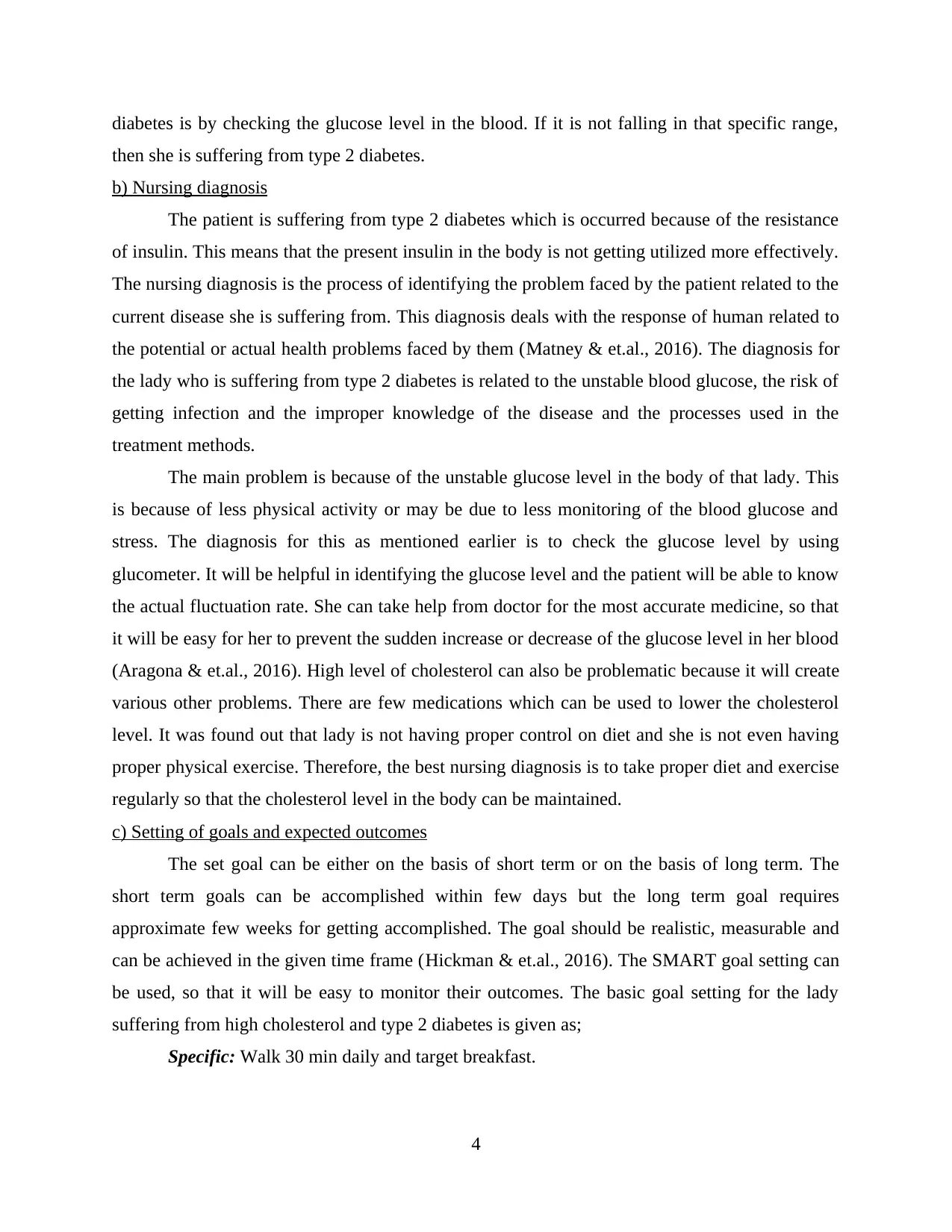
diabetes is by checking the glucose level in the blood. If it is not falling in that specific range,
then she is suffering from type 2 diabetes.
b) Nursing diagnosis
The patient is suffering from type 2 diabetes which is occurred because of the resistance
of insulin. This means that the present insulin in the body is not getting utilized more effectively.
The nursing diagnosis is the process of identifying the problem faced by the patient related to the
current disease she is suffering from. This diagnosis deals with the response of human related to
the potential or actual health problems faced by them (Matney & et.al., 2016). The diagnosis for
the lady who is suffering from type 2 diabetes is related to the unstable blood glucose, the risk of
getting infection and the improper knowledge of the disease and the processes used in the
treatment methods.
The main problem is because of the unstable glucose level in the body of that lady. This
is because of less physical activity or may be due to less monitoring of the blood glucose and
stress. The diagnosis for this as mentioned earlier is to check the glucose level by using
glucometer. It will be helpful in identifying the glucose level and the patient will be able to know
the actual fluctuation rate. She can take help from doctor for the most accurate medicine, so that
it will be easy for her to prevent the sudden increase or decrease of the glucose level in her blood
(Aragona & et.al., 2016). High level of cholesterol can also be problematic because it will create
various other problems. There are few medications which can be used to lower the cholesterol
level. It was found out that lady is not having proper control on diet and she is not even having
proper physical exercise. Therefore, the best nursing diagnosis is to take proper diet and exercise
regularly so that the cholesterol level in the body can be maintained.
c) Setting of goals and expected outcomes
The set goal can be either on the basis of short term or on the basis of long term. The
short term goals can be accomplished within few days but the long term goal requires
approximate few weeks for getting accomplished. The goal should be realistic, measurable and
can be achieved in the given time frame (Hickman & et.al., 2016). The SMART goal setting can
be used, so that it will be easy to monitor their outcomes. The basic goal setting for the lady
suffering from high cholesterol and type 2 diabetes is given as;
Specific: Walk 30 min daily and target breakfast.
4
then she is suffering from type 2 diabetes.
b) Nursing diagnosis
The patient is suffering from type 2 diabetes which is occurred because of the resistance
of insulin. This means that the present insulin in the body is not getting utilized more effectively.
The nursing diagnosis is the process of identifying the problem faced by the patient related to the
current disease she is suffering from. This diagnosis deals with the response of human related to
the potential or actual health problems faced by them (Matney & et.al., 2016). The diagnosis for
the lady who is suffering from type 2 diabetes is related to the unstable blood glucose, the risk of
getting infection and the improper knowledge of the disease and the processes used in the
treatment methods.
The main problem is because of the unstable glucose level in the body of that lady. This
is because of less physical activity or may be due to less monitoring of the blood glucose and
stress. The diagnosis for this as mentioned earlier is to check the glucose level by using
glucometer. It will be helpful in identifying the glucose level and the patient will be able to know
the actual fluctuation rate. She can take help from doctor for the most accurate medicine, so that
it will be easy for her to prevent the sudden increase or decrease of the glucose level in her blood
(Aragona & et.al., 2016). High level of cholesterol can also be problematic because it will create
various other problems. There are few medications which can be used to lower the cholesterol
level. It was found out that lady is not having proper control on diet and she is not even having
proper physical exercise. Therefore, the best nursing diagnosis is to take proper diet and exercise
regularly so that the cholesterol level in the body can be maintained.
c) Setting of goals and expected outcomes
The set goal can be either on the basis of short term or on the basis of long term. The
short term goals can be accomplished within few days but the long term goal requires
approximate few weeks for getting accomplished. The goal should be realistic, measurable and
can be achieved in the given time frame (Hickman & et.al., 2016). The SMART goal setting can
be used, so that it will be easy to monitor their outcomes. The basic goal setting for the lady
suffering from high cholesterol and type 2 diabetes is given as;
Specific: Walk 30 min daily and target breakfast.
4
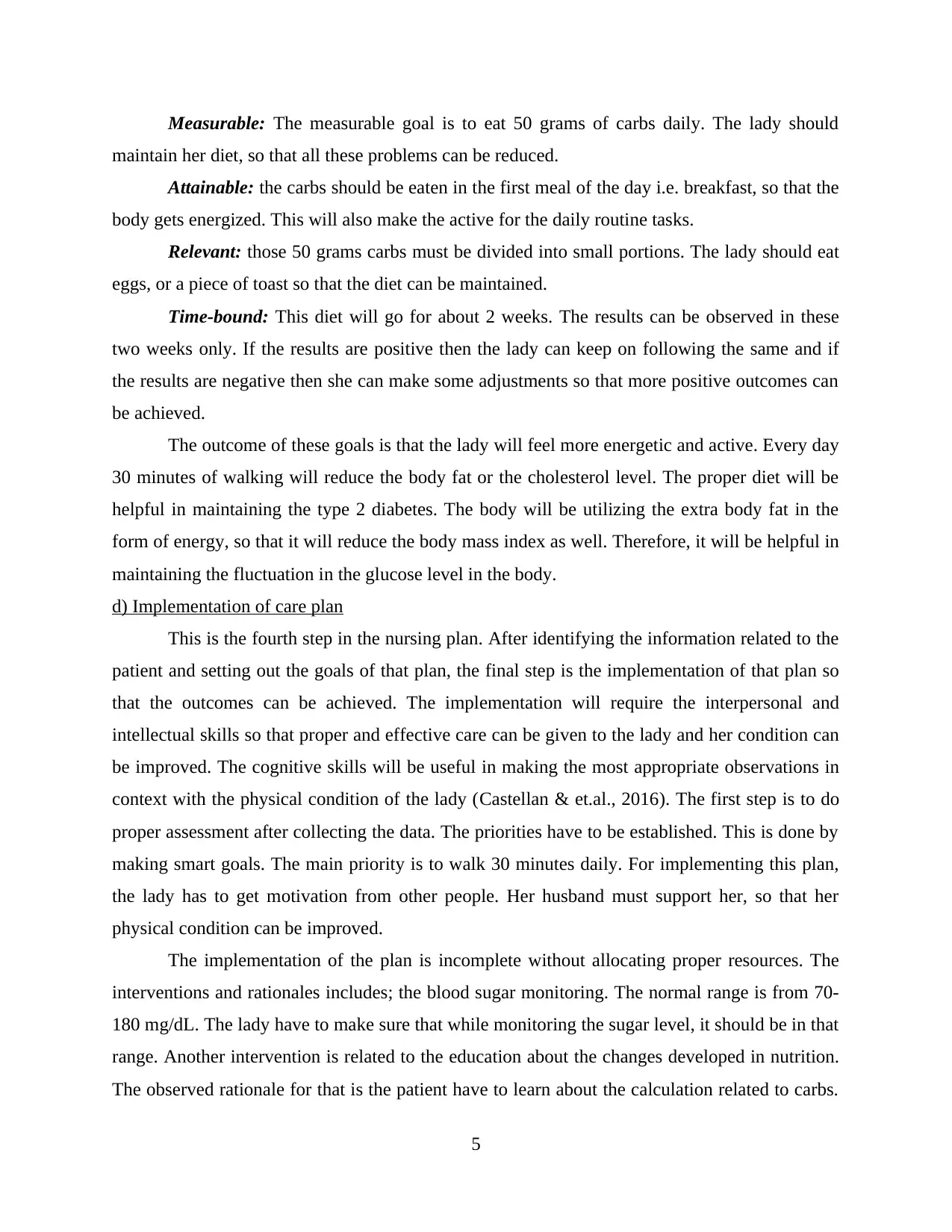
Measurable: The measurable goal is to eat 50 grams of carbs daily. The lady should
maintain her diet, so that all these problems can be reduced.
Attainable: the carbs should be eaten in the first meal of the day i.e. breakfast, so that the
body gets energized. This will also make the active for the daily routine tasks.
Relevant: those 50 grams carbs must be divided into small portions. The lady should eat
eggs, or a piece of toast so that the diet can be maintained.
Time-bound: This diet will go for about 2 weeks. The results can be observed in these
two weeks only. If the results are positive then the lady can keep on following the same and if
the results are negative then she can make some adjustments so that more positive outcomes can
be achieved.
The outcome of these goals is that the lady will feel more energetic and active. Every day
30 minutes of walking will reduce the body fat or the cholesterol level. The proper diet will be
helpful in maintaining the type 2 diabetes. The body will be utilizing the extra body fat in the
form of energy, so that it will reduce the body mass index as well. Therefore, it will be helpful in
maintaining the fluctuation in the glucose level in the body.
d) Implementation of care plan
This is the fourth step in the nursing plan. After identifying the information related to the
patient and setting out the goals of that plan, the final step is the implementation of that plan so
that the outcomes can be achieved. The implementation will require the interpersonal and
intellectual skills so that proper and effective care can be given to the lady and her condition can
be improved. The cognitive skills will be useful in making the most appropriate observations in
context with the physical condition of the lady (Castellan & et.al., 2016). The first step is to do
proper assessment after collecting the data. The priorities have to be established. This is done by
making smart goals. The main priority is to walk 30 minutes daily. For implementing this plan,
the lady has to get motivation from other people. Her husband must support her, so that her
physical condition can be improved.
The implementation of the plan is incomplete without allocating proper resources. The
interventions and rationales includes; the blood sugar monitoring. The normal range is from 70-
180 mg/dL. The lady have to make sure that while monitoring the sugar level, it should be in that
range. Another intervention is related to the education about the changes developed in nutrition.
The observed rationale for that is the patient have to learn about the calculation related to carbs.
5
maintain her diet, so that all these problems can be reduced.
Attainable: the carbs should be eaten in the first meal of the day i.e. breakfast, so that the
body gets energized. This will also make the active for the daily routine tasks.
Relevant: those 50 grams carbs must be divided into small portions. The lady should eat
eggs, or a piece of toast so that the diet can be maintained.
Time-bound: This diet will go for about 2 weeks. The results can be observed in these
two weeks only. If the results are positive then the lady can keep on following the same and if
the results are negative then she can make some adjustments so that more positive outcomes can
be achieved.
The outcome of these goals is that the lady will feel more energetic and active. Every day
30 minutes of walking will reduce the body fat or the cholesterol level. The proper diet will be
helpful in maintaining the type 2 diabetes. The body will be utilizing the extra body fat in the
form of energy, so that it will reduce the body mass index as well. Therefore, it will be helpful in
maintaining the fluctuation in the glucose level in the body.
d) Implementation of care plan
This is the fourth step in the nursing plan. After identifying the information related to the
patient and setting out the goals of that plan, the final step is the implementation of that plan so
that the outcomes can be achieved. The implementation will require the interpersonal and
intellectual skills so that proper and effective care can be given to the lady and her condition can
be improved. The cognitive skills will be useful in making the most appropriate observations in
context with the physical condition of the lady (Castellan & et.al., 2016). The first step is to do
proper assessment after collecting the data. The priorities have to be established. This is done by
making smart goals. The main priority is to walk 30 minutes daily. For implementing this plan,
the lady has to get motivation from other people. Her husband must support her, so that her
physical condition can be improved.
The implementation of the plan is incomplete without allocating proper resources. The
interventions and rationales includes; the blood sugar monitoring. The normal range is from 70-
180 mg/dL. The lady have to make sure that while monitoring the sugar level, it should be in that
range. Another intervention is related to the education about the changes developed in nutrition.
The observed rationale for that is the patient have to learn about the calculation related to carbs.
5
Paraphrase This Document
Need a fresh take? Get an instant paraphrase of this document with our AI Paraphraser
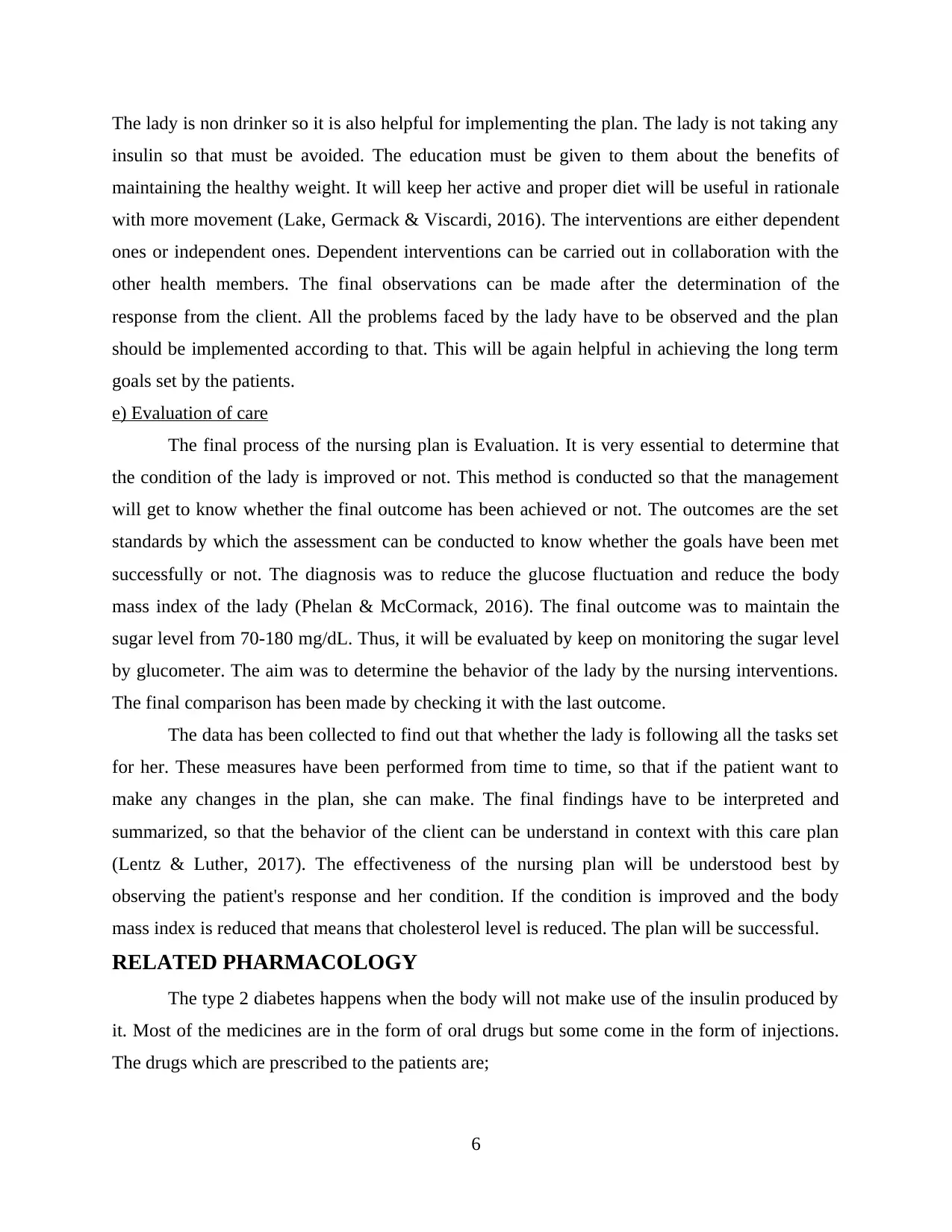
The lady is non drinker so it is also helpful for implementing the plan. The lady is not taking any
insulin so that must be avoided. The education must be given to them about the benefits of
maintaining the healthy weight. It will keep her active and proper diet will be useful in rationale
with more movement (Lake, Germack & Viscardi, 2016). The interventions are either dependent
ones or independent ones. Dependent interventions can be carried out in collaboration with the
other health members. The final observations can be made after the determination of the
response from the client. All the problems faced by the lady have to be observed and the plan
should be implemented according to that. This will be again helpful in achieving the long term
goals set by the patients.
e) Evaluation of care
The final process of the nursing plan is Evaluation. It is very essential to determine that
the condition of the lady is improved or not. This method is conducted so that the management
will get to know whether the final outcome has been achieved or not. The outcomes are the set
standards by which the assessment can be conducted to know whether the goals have been met
successfully or not. The diagnosis was to reduce the glucose fluctuation and reduce the body
mass index of the lady (Phelan & McCormack, 2016). The final outcome was to maintain the
sugar level from 70-180 mg/dL. Thus, it will be evaluated by keep on monitoring the sugar level
by glucometer. The aim was to determine the behavior of the lady by the nursing interventions.
The final comparison has been made by checking it with the last outcome.
The data has been collected to find out that whether the lady is following all the tasks set
for her. These measures have been performed from time to time, so that if the patient want to
make any changes in the plan, she can make. The final findings have to be interpreted and
summarized, so that the behavior of the client can be understand in context with this care plan
(Lentz & Luther, 2017). The effectiveness of the nursing plan will be understood best by
observing the patient's response and her condition. If the condition is improved and the body
mass index is reduced that means that cholesterol level is reduced. The plan will be successful.
RELATED PHARMACOLOGY
The type 2 diabetes happens when the body will not make use of the insulin produced by
it. Most of the medicines are in the form of oral drugs but some come in the form of injections.
The drugs which are prescribed to the patients are;
6
insulin so that must be avoided. The education must be given to them about the benefits of
maintaining the healthy weight. It will keep her active and proper diet will be useful in rationale
with more movement (Lake, Germack & Viscardi, 2016). The interventions are either dependent
ones or independent ones. Dependent interventions can be carried out in collaboration with the
other health members. The final observations can be made after the determination of the
response from the client. All the problems faced by the lady have to be observed and the plan
should be implemented according to that. This will be again helpful in achieving the long term
goals set by the patients.
e) Evaluation of care
The final process of the nursing plan is Evaluation. It is very essential to determine that
the condition of the lady is improved or not. This method is conducted so that the management
will get to know whether the final outcome has been achieved or not. The outcomes are the set
standards by which the assessment can be conducted to know whether the goals have been met
successfully or not. The diagnosis was to reduce the glucose fluctuation and reduce the body
mass index of the lady (Phelan & McCormack, 2016). The final outcome was to maintain the
sugar level from 70-180 mg/dL. Thus, it will be evaluated by keep on monitoring the sugar level
by glucometer. The aim was to determine the behavior of the lady by the nursing interventions.
The final comparison has been made by checking it with the last outcome.
The data has been collected to find out that whether the lady is following all the tasks set
for her. These measures have been performed from time to time, so that if the patient want to
make any changes in the plan, she can make. The final findings have to be interpreted and
summarized, so that the behavior of the client can be understand in context with this care plan
(Lentz & Luther, 2017). The effectiveness of the nursing plan will be understood best by
observing the patient's response and her condition. If the condition is improved and the body
mass index is reduced that means that cholesterol level is reduced. The plan will be successful.
RELATED PHARMACOLOGY
The type 2 diabetes happens when the body will not make use of the insulin produced by
it. Most of the medicines are in the form of oral drugs but some come in the form of injections.
The drugs which are prescribed to the patients are;
6
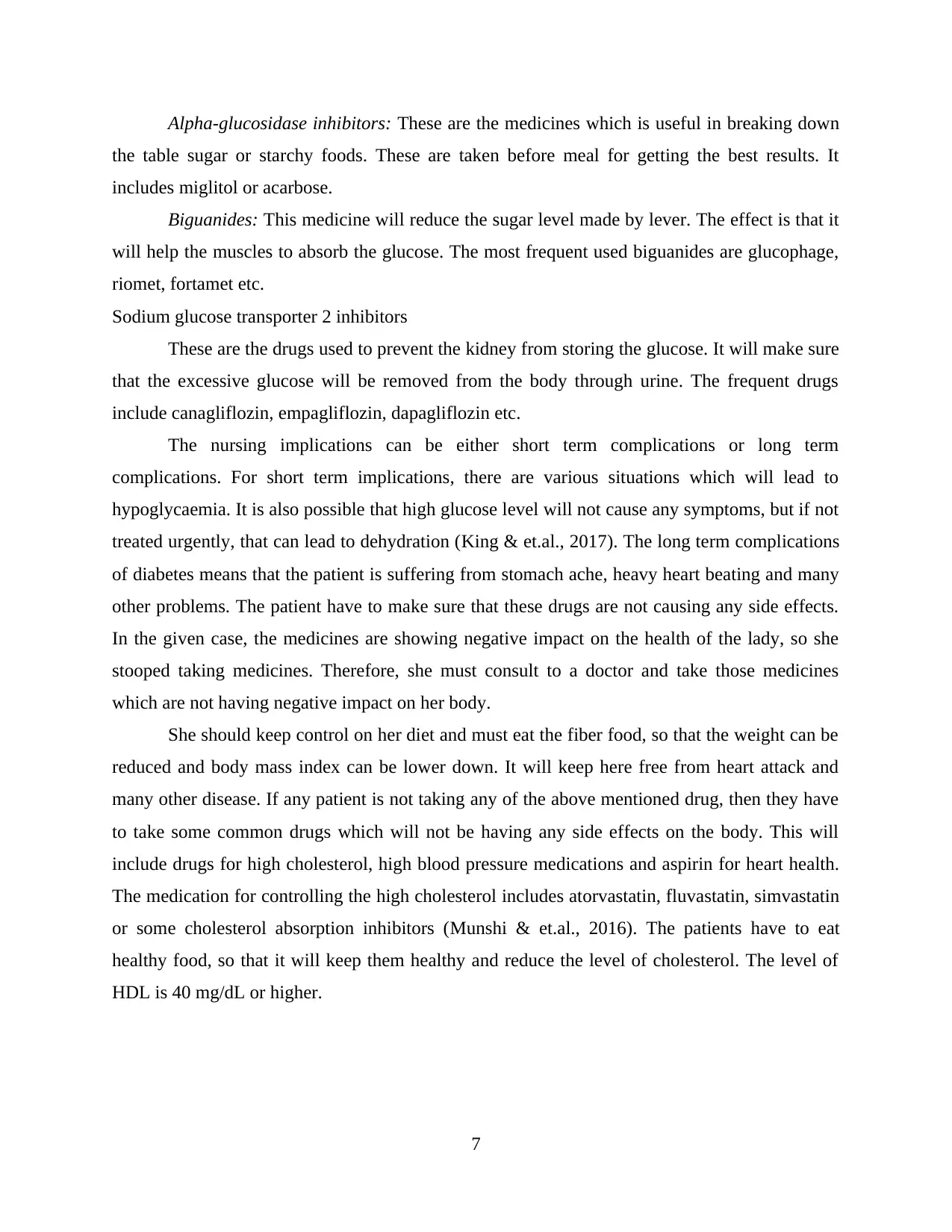
Alpha-glucosidase inhibitors: These are the medicines which is useful in breaking down
the table sugar or starchy foods. These are taken before meal for getting the best results. It
includes miglitol or acarbose.
Biguanides: This medicine will reduce the sugar level made by lever. The effect is that it
will help the muscles to absorb the glucose. The most frequent used biguanides are glucophage,
riomet, fortamet etc.
Sodium glucose transporter 2 inhibitors
These are the drugs used to prevent the kidney from storing the glucose. It will make sure
that the excessive glucose will be removed from the body through urine. The frequent drugs
include canagliflozin, empagliflozin, dapagliflozin etc.
The nursing implications can be either short term complications or long term
complications. For short term implications, there are various situations which will lead to
hypoglycaemia. It is also possible that high glucose level will not cause any symptoms, but if not
treated urgently, that can lead to dehydration (King & et.al., 2017). The long term complications
of diabetes means that the patient is suffering from stomach ache, heavy heart beating and many
other problems. The patient have to make sure that these drugs are not causing any side effects.
In the given case, the medicines are showing negative impact on the health of the lady, so she
stooped taking medicines. Therefore, she must consult to a doctor and take those medicines
which are not having negative impact on her body.
She should keep control on her diet and must eat the fiber food, so that the weight can be
reduced and body mass index can be lower down. It will keep here free from heart attack and
many other disease. If any patient is not taking any of the above mentioned drug, then they have
to take some common drugs which will not be having any side effects on the body. This will
include drugs for high cholesterol, high blood pressure medications and aspirin for heart health.
The medication for controlling the high cholesterol includes atorvastatin, fluvastatin, simvastatin
or some cholesterol absorption inhibitors (Munshi & et.al., 2016). The patients have to eat
healthy food, so that it will keep them healthy and reduce the level of cholesterol. The level of
HDL is 40 mg/dL or higher.
7
the table sugar or starchy foods. These are taken before meal for getting the best results. It
includes miglitol or acarbose.
Biguanides: This medicine will reduce the sugar level made by lever. The effect is that it
will help the muscles to absorb the glucose. The most frequent used biguanides are glucophage,
riomet, fortamet etc.
Sodium glucose transporter 2 inhibitors
These are the drugs used to prevent the kidney from storing the glucose. It will make sure
that the excessive glucose will be removed from the body through urine. The frequent drugs
include canagliflozin, empagliflozin, dapagliflozin etc.
The nursing implications can be either short term complications or long term
complications. For short term implications, there are various situations which will lead to
hypoglycaemia. It is also possible that high glucose level will not cause any symptoms, but if not
treated urgently, that can lead to dehydration (King & et.al., 2017). The long term complications
of diabetes means that the patient is suffering from stomach ache, heavy heart beating and many
other problems. The patient have to make sure that these drugs are not causing any side effects.
In the given case, the medicines are showing negative impact on the health of the lady, so she
stooped taking medicines. Therefore, she must consult to a doctor and take those medicines
which are not having negative impact on her body.
She should keep control on her diet and must eat the fiber food, so that the weight can be
reduced and body mass index can be lower down. It will keep here free from heart attack and
many other disease. If any patient is not taking any of the above mentioned drug, then they have
to take some common drugs which will not be having any side effects on the body. This will
include drugs for high cholesterol, high blood pressure medications and aspirin for heart health.
The medication for controlling the high cholesterol includes atorvastatin, fluvastatin, simvastatin
or some cholesterol absorption inhibitors (Munshi & et.al., 2016). The patients have to eat
healthy food, so that it will keep them healthy and reduce the level of cholesterol. The level of
HDL is 40 mg/dL or higher.
7

CONCLUSION
From this report, it has been concluded that the lady has followed the given medication.
By this she is able to reduce the side effects of high cholesterol and type 2 diabetes. The report
shows the smart goals which are used by the lady to treat the problems she is suffering from. It is
recommended to all those patients who are having type 2 diabetes that they take the medications
on time and maintain their diet. The developed care plan was useful for the lady and because of
that the body mass index and glucose fluctuation are not in control.
Further, this report also reflect the pharmacology used for the treatment of diabetes and
high cholesterol patients. It was also found out that healthy breakfast is the best way by which
healthy body can be maintained. Few nursing implications are also there but the patient has to
make sure that if the medicine is showing any side effects, then he/she has to consult with doctor
immediately. Finally, the evaluation was done and it was found out that the care plan has
achieved all the outcomes by which the health of the lady is improved.
8
From this report, it has been concluded that the lady has followed the given medication.
By this she is able to reduce the side effects of high cholesterol and type 2 diabetes. The report
shows the smart goals which are used by the lady to treat the problems she is suffering from. It is
recommended to all those patients who are having type 2 diabetes that they take the medications
on time and maintain their diet. The developed care plan was useful for the lady and because of
that the body mass index and glucose fluctuation are not in control.
Further, this report also reflect the pharmacology used for the treatment of diabetes and
high cholesterol patients. It was also found out that healthy breakfast is the best way by which
healthy body can be maintained. Few nursing implications are also there but the patient has to
make sure that if the medicine is showing any side effects, then he/she has to consult with doctor
immediately. Finally, the evaluation was done and it was found out that the care plan has
achieved all the outcomes by which the health of the lady is improved.
8
Secure Best Marks with AI Grader
Need help grading? Try our AI Grader for instant feedback on your assignments.
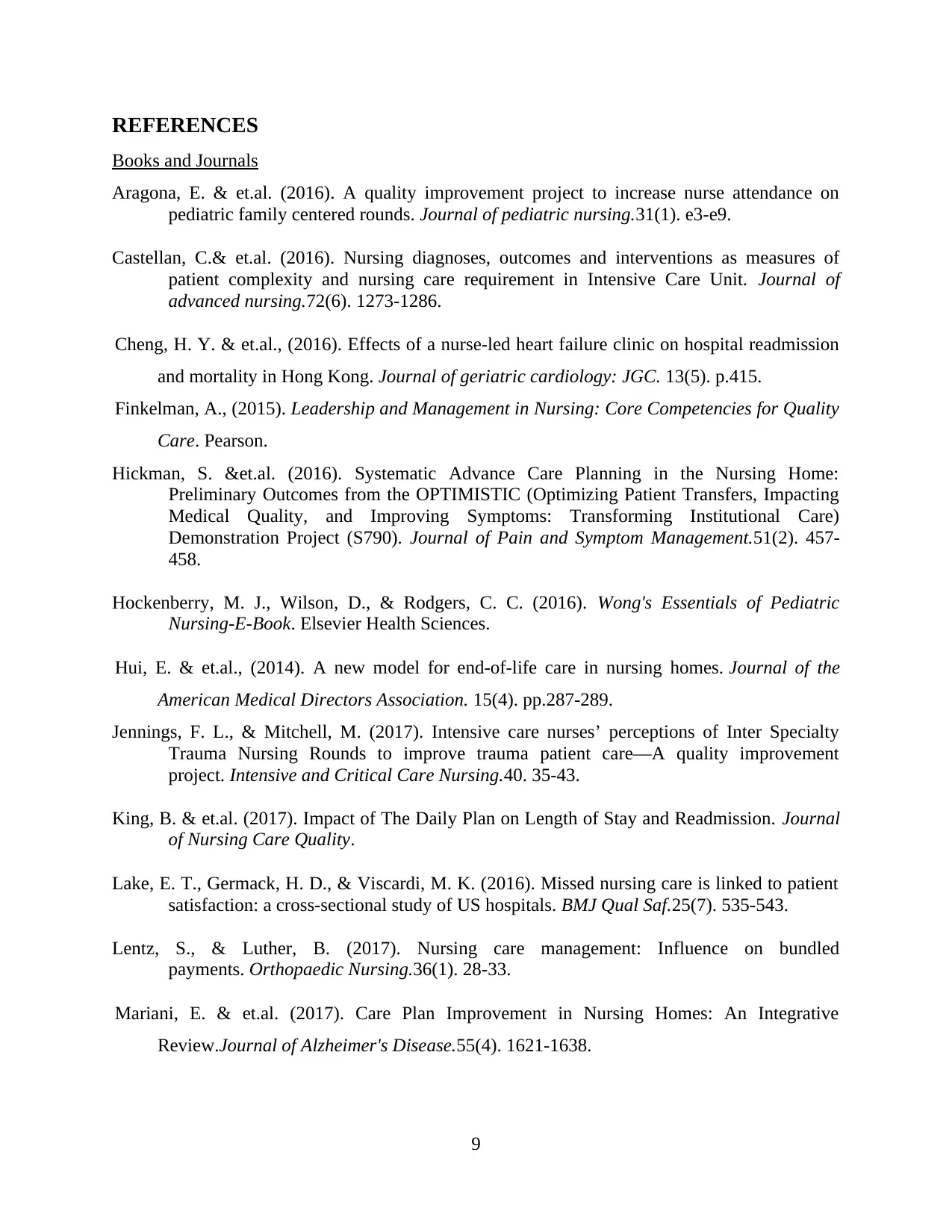
REFERENCES
Books and Journals
Aragona, E. & et.al. (2016). A quality improvement project to increase nurse attendance on
pediatric family centered rounds. Journal of pediatric nursing.31(1). e3-e9.
Castellan, C.& et.al. (2016). Nursing diagnoses, outcomes and interventions as measures of
patient complexity and nursing care requirement in Intensive Care Unit. Journal of
advanced nursing.72(6). 1273-1286.
Cheng, H. Y. & et.al., (2016). Effects of a nurse-led heart failure clinic on hospital readmission
and mortality in Hong Kong. Journal of geriatric cardiology: JGC. 13(5). p.415.
Finkelman, A., (2015). Leadership and Management in Nursing: Core Competencies for Quality
Care. Pearson.
Hickman, S. &et.al. (2016). Systematic Advance Care Planning in the Nursing Home:
Preliminary Outcomes from the OPTIMISTIC (Optimizing Patient Transfers, Impacting
Medical Quality, and Improving Symptoms: Transforming Institutional Care)
Demonstration Project (S790). Journal of Pain and Symptom Management.51(2). 457-
458.
Hockenberry, M. J., Wilson, D., & Rodgers, C. C. (2016). Wong's Essentials of Pediatric
Nursing-E-Book. Elsevier Health Sciences.
Hui, E. & et.al., (2014). A new model for end-of-life care in nursing homes. Journal of the
American Medical Directors Association. 15(4). pp.287-289.
Jennings, F. L., & Mitchell, M. (2017). Intensive care nurses’ perceptions of Inter Specialty
Trauma Nursing Rounds to improve trauma patient care—A quality improvement
project. Intensive and Critical Care Nursing.40. 35-43.
King, B. & et.al. (2017). Impact of The Daily Plan on Length of Stay and Readmission. Journal
of Nursing Care Quality.
Lake, E. T., Germack, H. D., & Viscardi, M. K. (2016). Missed nursing care is linked to patient
satisfaction: a cross-sectional study of US hospitals. BMJ Qual Saf.25(7). 535-543.
Lentz, S., & Luther, B. (2017). Nursing care management: Influence on bundled
payments. Orthopaedic Nursing.36(1). 28-33.
Mariani, E. & et.al. (2017). Care Plan Improvement in Nursing Homes: An Integrative
Review.Journal of Alzheimer's Disease.55(4). 1621-1638.
9
Books and Journals
Aragona, E. & et.al. (2016). A quality improvement project to increase nurse attendance on
pediatric family centered rounds. Journal of pediatric nursing.31(1). e3-e9.
Castellan, C.& et.al. (2016). Nursing diagnoses, outcomes and interventions as measures of
patient complexity and nursing care requirement in Intensive Care Unit. Journal of
advanced nursing.72(6). 1273-1286.
Cheng, H. Y. & et.al., (2016). Effects of a nurse-led heart failure clinic on hospital readmission
and mortality in Hong Kong. Journal of geriatric cardiology: JGC. 13(5). p.415.
Finkelman, A., (2015). Leadership and Management in Nursing: Core Competencies for Quality
Care. Pearson.
Hickman, S. &et.al. (2016). Systematic Advance Care Planning in the Nursing Home:
Preliminary Outcomes from the OPTIMISTIC (Optimizing Patient Transfers, Impacting
Medical Quality, and Improving Symptoms: Transforming Institutional Care)
Demonstration Project (S790). Journal of Pain and Symptom Management.51(2). 457-
458.
Hockenberry, M. J., Wilson, D., & Rodgers, C. C. (2016). Wong's Essentials of Pediatric
Nursing-E-Book. Elsevier Health Sciences.
Hui, E. & et.al., (2014). A new model for end-of-life care in nursing homes. Journal of the
American Medical Directors Association. 15(4). pp.287-289.
Jennings, F. L., & Mitchell, M. (2017). Intensive care nurses’ perceptions of Inter Specialty
Trauma Nursing Rounds to improve trauma patient care—A quality improvement
project. Intensive and Critical Care Nursing.40. 35-43.
King, B. & et.al. (2017). Impact of The Daily Plan on Length of Stay and Readmission. Journal
of Nursing Care Quality.
Lake, E. T., Germack, H. D., & Viscardi, M. K. (2016). Missed nursing care is linked to patient
satisfaction: a cross-sectional study of US hospitals. BMJ Qual Saf.25(7). 535-543.
Lentz, S., & Luther, B. (2017). Nursing care management: Influence on bundled
payments. Orthopaedic Nursing.36(1). 28-33.
Mariani, E. & et.al. (2017). Care Plan Improvement in Nursing Homes: An Integrative
Review.Journal of Alzheimer's Disease.55(4). 1621-1638.
9
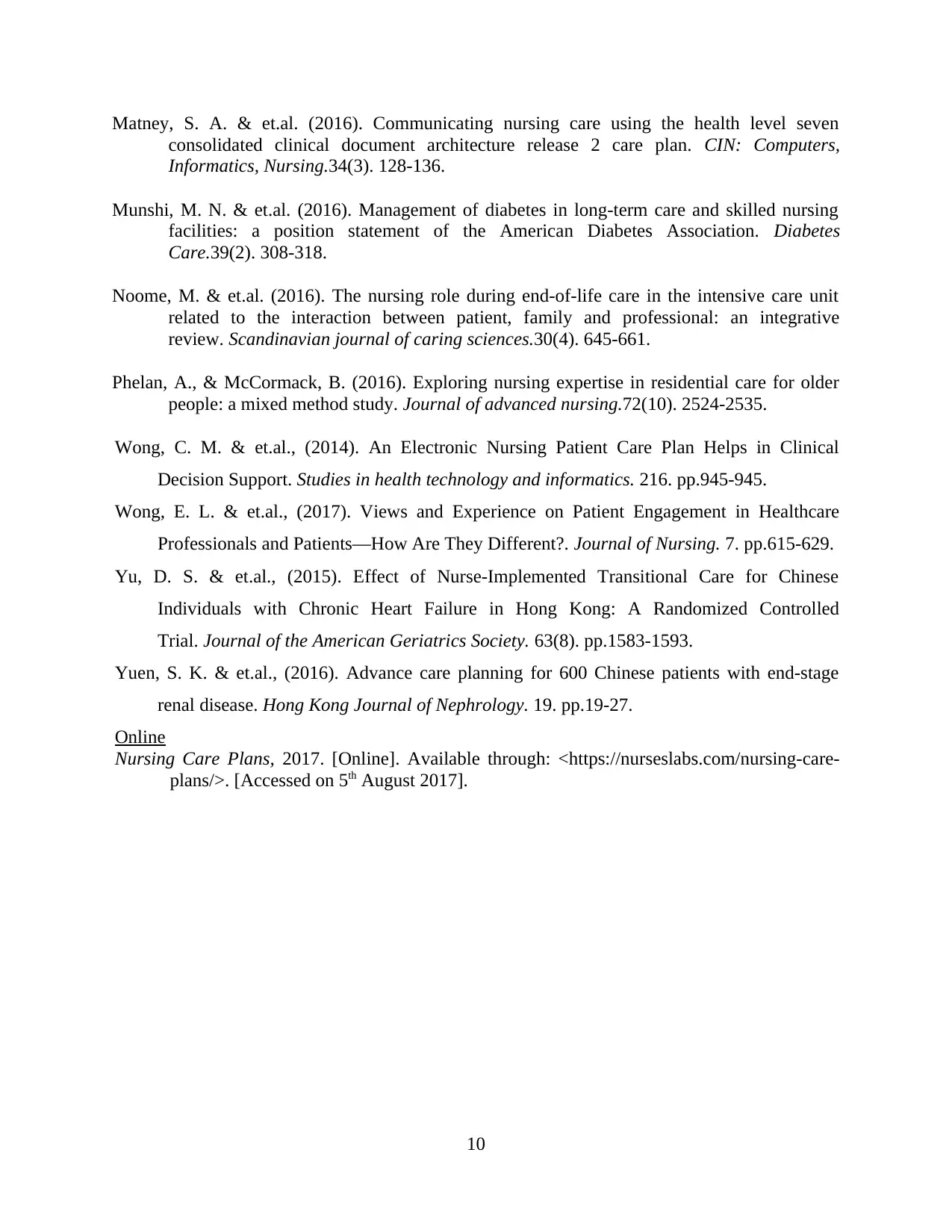
Matney, S. A. & et.al. (2016). Communicating nursing care using the health level seven
consolidated clinical document architecture release 2 care plan. CIN: Computers,
Informatics, Nursing.34(3). 128-136.
Munshi, M. N. & et.al. (2016). Management of diabetes in long-term care and skilled nursing
facilities: a position statement of the American Diabetes Association. Diabetes
Care.39(2). 308-318.
Noome, M. & et.al. (2016). The nursing role during end‐of‐life care in the intensive care unit
related to the interaction between patient, family and professional: an integrative
review. Scandinavian journal of caring sciences.30(4). 645-661.
Phelan, A., & McCormack, B. (2016). Exploring nursing expertise in residential care for older
people: a mixed method study. Journal of advanced nursing.72(10). 2524-2535.
Wong, C. M. & et.al., (2014). An Electronic Nursing Patient Care Plan Helps in Clinical
Decision Support. Studies in health technology and informatics. 216. pp.945-945.
Wong, E. L. & et.al., (2017). Views and Experience on Patient Engagement in Healthcare
Professionals and Patients—How Are They Different?. Journal of Nursing. 7. pp.615-629.
Yu, D. S. & et.al., (2015). Effect of Nurse‐Implemented Transitional Care for Chinese
Individuals with Chronic Heart Failure in Hong Kong: A Randomized Controlled
Trial. Journal of the American Geriatrics Society. 63(8). pp.1583-1593.
Yuen, S. K. & et.al., (2016). Advance care planning for 600 Chinese patients with end-stage
renal disease. Hong Kong Journal of Nephrology. 19. pp.19-27.
Online
Nursing Care Plans, 2017. [Online]. Available through: <https://nurseslabs.com/nursing-care-
plans/>. [Accessed on 5th August 2017].
10
consolidated clinical document architecture release 2 care plan. CIN: Computers,
Informatics, Nursing.34(3). 128-136.
Munshi, M. N. & et.al. (2016). Management of diabetes in long-term care and skilled nursing
facilities: a position statement of the American Diabetes Association. Diabetes
Care.39(2). 308-318.
Noome, M. & et.al. (2016). The nursing role during end‐of‐life care in the intensive care unit
related to the interaction between patient, family and professional: an integrative
review. Scandinavian journal of caring sciences.30(4). 645-661.
Phelan, A., & McCormack, B. (2016). Exploring nursing expertise in residential care for older
people: a mixed method study. Journal of advanced nursing.72(10). 2524-2535.
Wong, C. M. & et.al., (2014). An Electronic Nursing Patient Care Plan Helps in Clinical
Decision Support. Studies in health technology and informatics. 216. pp.945-945.
Wong, E. L. & et.al., (2017). Views and Experience on Patient Engagement in Healthcare
Professionals and Patients—How Are They Different?. Journal of Nursing. 7. pp.615-629.
Yu, D. S. & et.al., (2015). Effect of Nurse‐Implemented Transitional Care for Chinese
Individuals with Chronic Heart Failure in Hong Kong: A Randomized Controlled
Trial. Journal of the American Geriatrics Society. 63(8). pp.1583-1593.
Yuen, S. K. & et.al., (2016). Advance care planning for 600 Chinese patients with end-stage
renal disease. Hong Kong Journal of Nephrology. 19. pp.19-27.
Online
Nursing Care Plans, 2017. [Online]. Available through: <https://nurseslabs.com/nursing-care-
plans/>. [Accessed on 5th August 2017].
10
1 out of 12
Related Documents
Your All-in-One AI-Powered Toolkit for Academic Success.
+13062052269
info@desklib.com
Available 24*7 on WhatsApp / Email
![[object Object]](/_next/static/media/star-bottom.7253800d.svg)
Unlock your academic potential
© 2024 | Zucol Services PVT LTD | All rights reserved.





